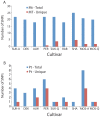Whole mitochondrial and plastid genome SNP analysis of nine date palm cultivars reveals plastid heteroplasmy and close phylogenetic relationships among cultivars
- PMID: 24718264
- PMCID: PMC3981771
- DOI: 10.1371/journal.pone.0094158
Whole mitochondrial and plastid genome SNP analysis of nine date palm cultivars reveals plastid heteroplasmy and close phylogenetic relationships among cultivars
Abstract
Date palm is a very important crop in western Asia and northern Africa, and it is the oldest domesticated fruit tree with archaeological records dating back 5000 years. The huge economic value of this crop has generated considerable interest in breeding programs to enhance production of dates. One of the major limitations of these efforts is the uncertainty regarding the number of date palm cultivars, which are currently based on fruit shape, size, color, and taste. Whole mitochondrial and plastid genome sequences were utilized to examine single nucleotide polymorphisms (SNPs) of date palms to evaluate the efficacy of this approach for molecular characterization of cultivars. Mitochondrial and plastid genomes of nine Saudi Arabian cultivars were sequenced. For each species about 60 million 100 bp paired-end reads were generated from total genomic DNA using the Illumina HiSeq 2000 platform. For each cultivar, sequences were aligned separately to the published date palm plastid and mitochondrial reference genomes, and SNPs were identified. The results identified cultivar-specific SNPs for eight of the nine cultivars. Two previous SNP analyses of mitochondrial and plastid genomes identified substantial intra-cultivar ( = intra-varietal) polymorphisms in organellar genomes but these studies did not properly take into account the fact that nearly half of the plastid genome has been integrated into the mitochondrial genome. Filtering all sequencing reads that mapped to both organellar genomes nearly eliminated mitochondrial heteroplasmy but all plastid SNPs remained heteroplasmic. This investigation provides valuable insights into how to deal with interorganellar DNA transfer in performing SNP analyses from total genomic DNA. The results confirm recent suggestions that plastid heteroplasmy is much more common than previously thought. Finally, low levels of sequence variation in plastid and mitochondrial genomes argue for using nuclear SNPs for molecular characterization of date palm cultivars.
Conflict of interest statement
Figures



References
-
- Jaradat AA (2011) Biodiversity of date palm, land use, land cover and soil sciences, In: Encyclopedia of Life Support Systems, Eolss Publishers, Oxford, UK, pp 1–31.
-
- Popenoe P (1973) The Date Palm. In: Field H (ed.) Field Research Projects, Coconut Grove, Miami, Florida.
-
- Zohary D, Spiegel-Roy P (1975) Beginnings of fruit growing in the Old World. Science 187: 319–327. - PubMed
-
- Al-Shahib W, Marshall RJ (2003) The fruit of the date palm: its possible use as the best food for the future? Internat J Food Sci Nutr 54: 247–259. - PubMed
-
- El Hadrami I, El Hadrami A (2009) Breeding date palm. In: Jain SM, Priyadarshan PM (eds.) Breeding Plantation Tree Crops, Springer, New York, pp 191–216.
Publication types
MeSH terms
Substances
LinkOut - more resources
Full Text Sources
Other Literature Sources

